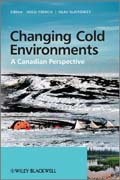
Changing Cold Environments; A Canadian Perspective is a comprehensive overview of the changing nature of the physical attributes of Canada's cold environments and the implications of these changes to cold environments on a global scale. The book places particular emphasis on the broader environmental science and sustainability issues that are of increasing concern to all cold regions ifpresent global climate trends continue. Clearly structured throughout, the book focuses on those elements of Canada's cold environments that will be most affected by global climate change - namely, the tundra, sub-arctic and boreal forest regions of northern Canada, and the high mid-latitude mountains of western Canada. The book considers the implications this will have for similar environments around the world. INDICE: List of Contributors xi Preface xiii Glossary xv PART ONE SPATIAL AND TEMPORAL VARIABILITY OF CANADA'S COLD ENVIRONMENTS 1 1 Cold Canada and theChanging Cryosphere 3 Hugh French and Olav Slaymaker 1.1 Introduction 3 1.2 The Cryosphere 4 1.3 Cold Canada 10 1.4 Cold Climates 15 1.5 Arctic and Alpine Considerations 19 1.6 Canada's Physical Geography 21 2 The Late Quaternary Glaciation of Northern Canada 26 David Evans 2.1 Introduction 26 2.2 Landforms and the Late Quaternary Glaciations 26 2.3 Late Quaternary Sea level Change and its Relationship to Glaciation History 39 2.4 Late Quaternary Glaciation and Deglacial History 39 2.5 Wider Implications of Canadian Arctic Ice Sheet Dynamics 42 2.6 Holocene Glacial Events 44 3 The Evolution of Polar Desert and Tundra Ecosystems 48 Konrad Gajewski 3.1 Introduction 48 3.2 The Nature of the Environment 49 3.3 Ecology of Arctic Plants 51 3.4 Vegetation Zonation 53 3.5 Arctic Oases 55 3.6 Long term Evolution of Canadian Arctic Ecosystems 56 3.7 The Quaternary 58 3.8 Postglacial Climate and Vegetation Change in Arctic Canada 594 Remote Sensing and Canadian Snow Climatology 66 Richard Kelly 4.1 Introduction 66 4.2 The Importance of Snow in the Earth System 66 4.3 Snow Measurementsin Canada 67 4.4 Remote Sensing of Snow 70 4.5 Snow Variations Inferred from Remote Sensing Observations 77 4.6 Discussion 82 4.7 Conclusion 82 PART TWO THE CHANGING CRYOSPHERE 87 5 The Changing Climates 89 Roger Barry and Mark Serreze 5.1 Introduction 89 5.2 Late Pliocene 89 5.3 Quaternary History 90 5.4 Postglacial Conditions 91 5.5 The Last Two Millennia 92 5.6 Recent Changes 94 5.7 The Future 96 6 Snow and Runoff: Processes, Sensitivity and Vulnerability 105 Ming-Ko Woo and John Pomeroy 6.1 Introduction 105 6.2 Snow Accumulation 107 6.3 Land Cover 109 6.4 Snow Ablation 111 6.5 Snowmelt Runoff Processes 113 6.6 Streamflow 117 6.7 Snowmelt Floods in Large Basins 118 6.8 Snow Vulnerability 122 7 Permafrost Distribution and Stability 126 Chris Burn 7.1 Introduction 1267.2 Distribution of Permafrost 130 7.3 Thermal Regime of Permafrost 134 7.4 Permafrost and Climate Change 136 7.5 Conclusions 143 8 Sea Ice in Canada 147 David Barber and Jennifer Lukovich 8.1 Introduction 147 8.2 What is Sea Ice? 147 8.3 The Physical Nature of Sea Ice 148 8.4 Spatial and Temporal Distributionof Sea Ice 150 8.5 Sea Ice and Climate Change 158 8.6 Implications for Northern Communities, Economic Development and the Environment 160 9 Lake and River Ice in Canada 163 Terry Prowse 9.1 Introduction 163 9.2 Role in the Climate System 168 9.3 Climatic Controls 168 9.4 Historical Trends and Linkages to Climate 169 9.5 Future Ice Regime Projections 172 9.6 Implications of Ice Regime Changes 173 PART THREE THE EVER-CHANGING SCENERY 183 10 Climate Change and the Central Canadian Treeline 185 Glen MacDonald 10.1 Introduction 185 10.2 The Central Canadian Treeline Zone Today 186 10.3 Current Warming at the Central Canadian Treeline 188 10.4 Response of the Centra
- ISBN: 978-0-470-69969-0
- Editorial: John Wiley & Sons
- Encuadernacion: Rústica
- Páginas: 340
- Fecha Publicación: 04/11/2011
- Nº Volúmenes: 1
- Idioma: Inglés
